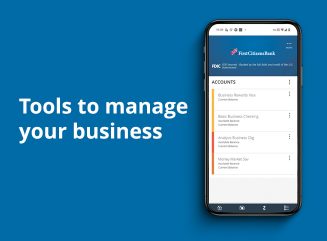Digital banking for business
Seamlessly access all of your accounts from one place with First Citizens Digital Banking for business.

Invest how you want, when you want, in real time with Self-Directed Investing.

Seamlessly access all of your accounts from one place with First Citizens Digital Banking for business.
We're committed to serving companies as they expand and succeed. The proof is in our success stories.
2026 Market Outlook video: Available now
The Making Sense team reflects on 2025 and discusses key headwinds and tailwinds for 2026.
University fundraising strategies enable schools to continue their missions devoted to educational and research excellence. Funds raised today fuel the projects and initiatives of tomorrow, allowing universities and their various departments not just to keep pace with industry trends but help their students set them.

Successful fundraising has two key components: a commitment to best practices and an investment in creative strategies. Your university can perform a check-in on current fundraising efforts and see how well they align with current best practices. From there, explore creative strategies to help you connect with more donors to bolster your fundraising base.
Diversifying your donor sources can help ensure a consistent flow of funds for a range of initiatives. Given that many donors don't necessarily see universities as causes in the same class as their favorite nonprofits, it's up to universities to define the work a donor's dollars will enable. Use the fundraising best practices below as a guidepost for your current efforts and help shore up any of the essentials you might have missed in developing and evolving your programs.
Fundraising shouldn't be the only time you communicate with your donors. Build relationships with your donors through regular communications. Consider creating newsletters, blog articles, annual reports, social media content and alumni magazines. When you already have a relationship with your donors, they're more likely to feel like they're part of your institution—and will likely want to give toward your fundraising efforts.
When you do ask for funds, clearly explain how dollars previously donated have been put to work. You can do this in a visually appealing way, such as an infographic, or with a simple sentence. For example:
Your generous donation to the School of Engineering empowered us to underwrite 10 new scholarships this year, ensuring that students can attend regardless of their financial need or background.
When communicating with alumni, it's essential that you analyze your alumni donor base and make your communications specific to their experiences and affiliations.
Create a sense of common purpose for students through volunteer groups and clubs, and give them traditions that they'll carry with them long after they graduate. Build a collaborative culture by giving students, staff and alumni opportunities to work on projects and initiatives together.
Give alumni an opportunity to gather with alumni networking events. This shows that you understand their needs and wants—and also gives you the opportunity to gain them as donors.
The campaigns you use to reach current and prospective donors should use a multi-channel approach. The consistent decline in phone donations means that development strategies have to meet donors where they are instead of where you used to find them. Today's most effective fundraising efforts include phone, text, email and direct mail to ensure that donors will have multiple touchpoints with the campaign, increasing the likelihood of securing a donation.
To increase campaign efficacy, consider targeting communications coordinated with important dates from a student's experience at your university. Depending on their social activity and major, those dates could include homecoming, a donation anniversary or the date where they received a major award for a research project or sporting event.
Your institution should maintain a strong relationship with all donors to encourage them to make repeat gifts. The amount of stewardship you provide should be proportionate to the donor's gift and expectations. Large donors may expect a personal relationship, invitations to events and a mention in your annual report.
Your institution likely won't be able to maintain a personal relationship with every donor. But there are other ways you can steward smaller donors. Processing donations efficiently, thanking donors, publicly recognizing them, inviting them to events, sending them progress reports and sharing photos and impactful stories are all ways to create positive donor experiences.
Make sure you're leveraging digital tools like mobile and social media fundraising within your campaigns. This will help make donations easy on the go and give consumers the type of frictionless transaction they appreciate.
Both digital and paper donor forms can incorporate a PayPal link. You can launch fundraising campaigns on social media sites like Facebook to target specific alumni networks on that platform. Whatever digital tools you use, make sure you have human components working alongside them. Ambassadors can be alumni who are excited to help promote your fundraiser and use their networks to share the university's campaign far and wide.
If you're relying on cash for in-person donation, many people who might otherwise give won't be able to. Instead, offer donor kiosks, which allow donors to give with credit cards and smart devices, including their phones. A kiosk also allows you to capture a donor's name and email address so you can stay in touch with them and solicit more donations in the future.
When you've assessed your current communication strategies to improve your campaigns across multiple channels, you can begin to explore more creative ways to cultivate your donor base.
Matching gift programs may offer an untapped resource for cultivating new dollars from existing donor bases. As most matching gift programs are use-it-or-lose-it annual benefits with most employers, you can create specialty fundraising campaigns designed to reach existing donors who might be able to give more with little effort on their part.
To help cultivate large donors in the community, consider going beyond your existing donor database and reaching out to the community. For example, an art school could create an outreach program for philanthropists who have a proven track record in supporting the arts. Finding ways to create a connection between the work of the school and a philanthropist's work in the community can help bring in new donors who previously had no affiliation with your school.
Peer-to-peer fundraising campaigns can put recent alumni to work for a good cause. You can create goals like funding a single scholarship, and then your digitally-savvy alumni can use their social media connections to drive donations. Peer campaigns are powerful tools that can help recent grads who might not have the means to donate themselves raise funds from their peer and alumni groups.
University fundraising doesn't have to be stale. It could just take a quick review of your commitment to best practices and revisiting some more creative strategies to increase gifts and fuel the future.



This material is for informational purposes only and is not intended to be an offer, specific investment strategy, recommendation or solicitation to purchase or sell any security or insurance product, and should not be construed as legal, tax or accounting advice. Please consult with your legal or tax advisor regarding the particular facts and circumstances of your situation prior to making any financial decision. While we believe that the information presented is from reliable sources, we do not represent, warrant or guarantee that it is accurate or complete.
Third parties mentioned are not affiliated with First-Citizens Bank & Trust Company.
Links to third-party websites may have a privacy policy different from First Citizens Bank and may provide less security than this website. First Citizens Bank and its affiliates are not responsible for the products, services and content on any third-party website.

Treasury & Cash Management
Electronic Bill Presentment & Payment
Investment & Retirement Services
Community Association Banking
Equipment Financing & Leasing
Credit Cards
Merchant Services
Email Us
Please select the option that best matches your needs.
Customers with account-related questions who aren't enrolled in Digital Banking or who would prefer to talk with someone can call us directly.